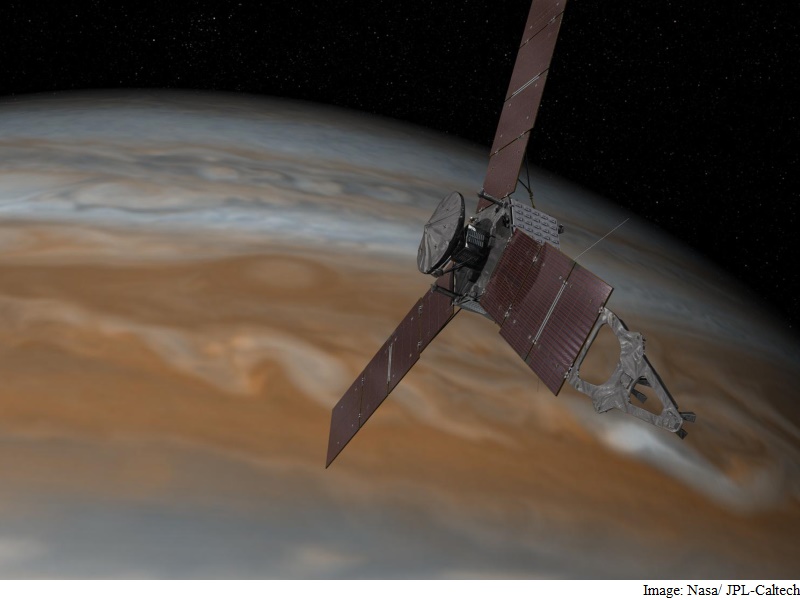- Home
- Science
- Science News
- Nasa's Juno Spacecraft Adjusts Flight Path for Date With Jupiter
Nasa's Juno Spacecraft Adjusts Flight Path for Date With Jupiter

Set to arrive at Jupiter this year to study the giant planet from an elliptical, polar orbit, Nasa's solar-powered Juno spacecraft successfully executed a manoeuvre to adjust its flight path on Wednesday.
"This is the first of two trajectory adjustments that fine tune Juno's orbit around the Sun, perfecting our rendezvous with Jupiter on July 4," said Scott Bolton, Juno principal investigator at the Southwest Research Institute in San Antonio.
The Juno spacecraft's thrusters consumed about 0.6kg of fuel during the burn and changed the spacecraft's speed by 0.31 metres per second.
At the time of the manoeuvre, Juno was about 82 million kilometres from Jupiter and approximately 684 million kilometres from Earth.
The next trajectory correction manoeuvre is scheduled on May 31.
Launched on August 5, 2011, thee spacecraft will orbit the Jovian world 33 times, skimming to within 5,000 kilometres above the planet's cloud tops every 14 days.
During the flybys, Juno will probe beneath the obscuring cloud cover of Jupiter and study its aurorae to learn more about the planet's origins, structure, atmosphere and magnetosphere.
Last month, Nasa announced its Juno spacecraft had broken the record to become humanity's most distant solar-powered emissary, achieving the milestone when it was about 793 million km from the Sun.
Juno is the first solar-powered spacecraft designed to operate at such a great distance from the Sun.
The four-ton Juno spacecraft carries three 30-foot-long solar arrays festooned with 18,698 individual solar cells.
Catch the latest from the Consumer Electronics Show on Gadgets 360, at our CES 2026 hub.
Related Stories
- Samsung Galaxy Unpacked 2025
- ChatGPT
- Redmi Note 14 Pro+
- iPhone 16
- Apple Vision Pro
- Oneplus 12
- OnePlus Nord CE 3 Lite 5G
- iPhone 13
- Xiaomi 14 Pro
- Oppo Find N3
- Tecno Spark Go (2023)
- Realme V30
- Best Phones Under 25000
- Samsung Galaxy S24 Series
- Cryptocurrency
- iQoo 12
- Samsung Galaxy S24 Ultra
- Giottus
- Samsung Galaxy Z Flip 5
- Apple 'Scary Fast'
- Housefull 5
- GoPro Hero 12 Black Review
- Invincible Season 2
- JioGlass
- HD Ready TV
- Laptop Under 50000
- Smartwatch Under 10000
- Latest Mobile Phones
- Compare Phones
- OPPO A6 Pro 5G
- OPPO A6s
- OPPO Reno 15 Pro Max
- Honor Win RT
- Honor Win
- Xiaomi 17 Ultra Leica Edition
- Xiaomi 17 Ultra
- Huawei Nova 15
- Asus ProArt P16
- MacBook Pro 14-inch (M5, 2025)
- OPPO Pad Air 5
- Huawei MatePad 11.5 (2026)
- Xiaomi Watch 5
- Huawei Watch 10th Anniversary Edition
- Acerpure Nitro Z Series 100-inch QLED TV
- Samsung 43 Inch LED Ultra HD (4K) Smart TV (UA43UE81AFULXL)
- Asus ROG Ally
- Nintendo Switch Lite
- Haier 1.6 Ton 5 Star Inverter Split AC (HSU19G-MZAID5BN-INV)
- Haier 1.6 Ton 5 Star Inverter Split AC (HSU19G-MZAIM5BN-INV)

















